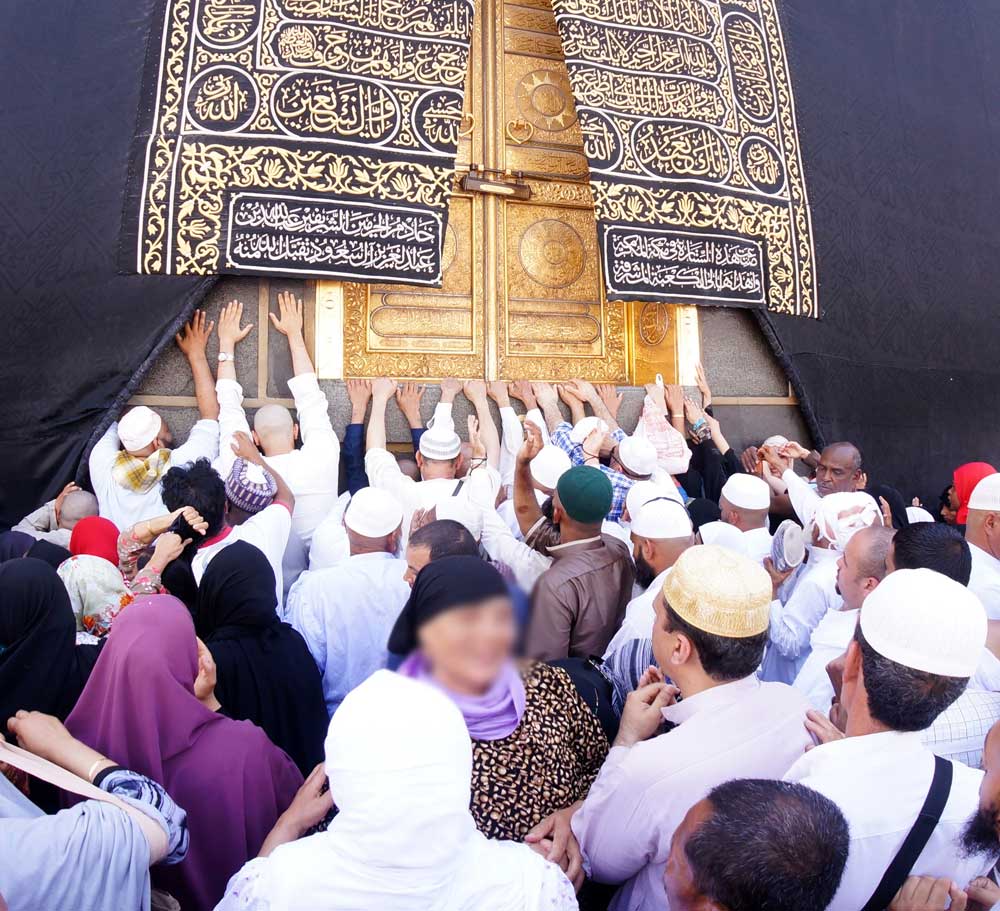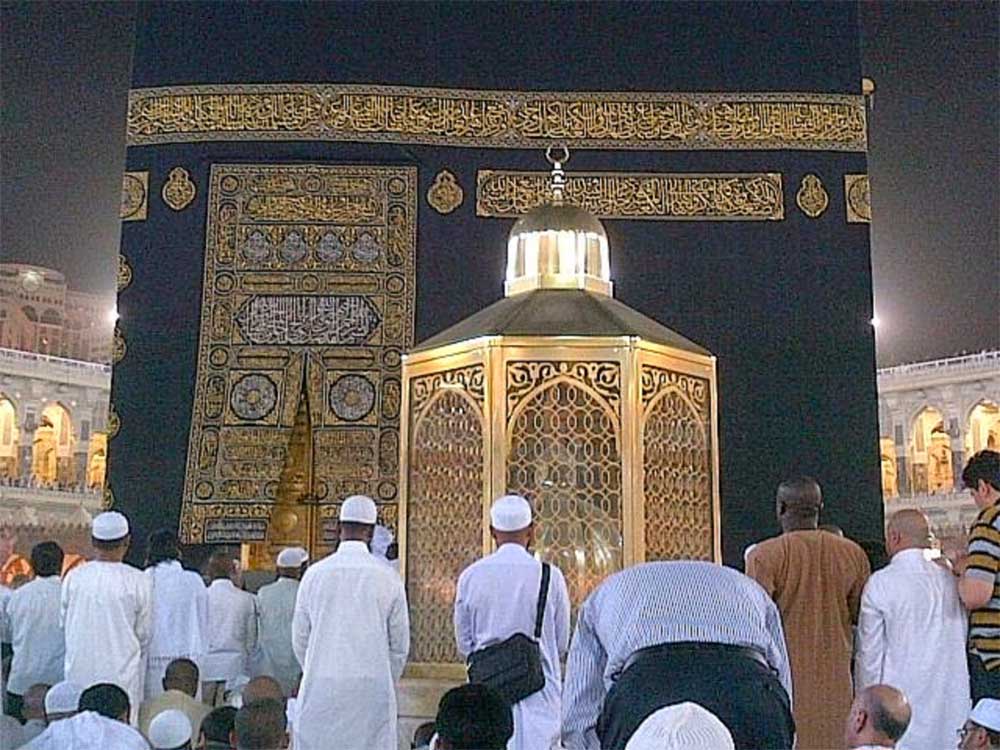Tawaf of Ka'bah
Tawaf means circling around something. Here it means moving around Ka' bah seven times with extreme love and devotion.

Preparation
After entering Masjid al-Haram, reach the Mataaf & proceed towards Hajar-e-Aswad. Now pass the upper sheet of Ihram from underneath the right arm and put it on the left shoulder. This act bares the right shoulder and is known as Iztaba. Reciting of Talbiyah is stopped when you reach Hajar-e-Aswad, the starting point of tawaf. Ablution (wudu) is essential for tawaf.
Niyyah (Intention)
Stand in front of Ka' bah facing Hajar-e-Aswad (the Black Stone) in such a way that the whole Hajre-e-Aswad is on your right side and the Rukn Yamani is on your left side. To achieve this end, you may get help from the black stripe on the floor. This stripe should be on your right side. Then without raising your hands make Niyyah (intention) for Tawaf, which is Waajib:
اللهم انى اريد طواف بيتك الحرام فيسره لي وتقبله مني سبعة اشواط الله تعالى عز وجل
" Allahumma inni uridu tawafa baitikal harrami fayassirhu li wa taqabbalhu minni sab’ ata ashwathin Allahita’ ala Azzawajal"
(O Allah, I intend to perform Tawaf around Your sacred house, seven circuits for Allah, who is Mighty and Dignified. Hence make it easy for me and accept it from me)
Istilam

Now moving towards right, come in front of Hajar-e-Aswad and kiss it if possible, or touch it with a stick and kiss the stick; if that also is not possible, raise your hands to your ears keeping your open palms towards Hajre-e-Aswad and say:
بِسْمِ اللَّهِ, اَللَّهُ أكبر, و لِلَّهِ الحَمدَ
" Bismillahi Allahu Akbar Wa Lilla Hil Hamd"
(In the name of Allah, Allah is the greatest, and All praise belong to Allah)
and drop your hands down. Now point the palms of your hands again towards Hajar-e-Aswad and kiss them. This act of kissing Hajar-e-Aswad or pointing towards it is called Istilam.
WARNING
The authorities often apply perfume to Hajar-e-Aswad, Rukn Yamani and Multazam. If so, do not touch them while in the state of Ihram, otherwise a dum will be required as a penalty.
During tawaf, it is not permissible to face or turn your back towards Ka' bah except when you are kissing or pointing towards Hajar-e-Aswad.
Tawaf Starts
After Istilam, turn right and start tawaf counter clockwise.
Ramal
For the first three circuits of Tawaf of Umrah and Tawaf of Arrival, men are required to move their shoulders and walk with quick short steps. This act is called Ramal and is Sunnah. They walk normally during the remaining four circuits.
Supplications of Tawaf
There are no fixed supplications for tawaf but there are several recommended supplications listed in the books of Hajj and Umrah out of which the following supplication is easy to memorize:
سُبْحَانَ اللّهِ ، والْحَمْدُللّهِ ، وَ لا اِلهَ اِلَّا اللّهُ ، وَ اللّهُ اَكْبَرُ ، وَلا حَوْلَ وَلا قُوَّةَ إِلا بِالله
" Subhan-Allah wal-hamdu-lillahi wa la ilaha ill-Allah wa-Allahu Akbar wa la haula wa la quwwata illa-billah."
(Glory be to Allah, All Praise is for Allah, There is No God but Allah, Allah is the Greatest, There is no might nor power except in Allah)
If you don' t remember these words, you may glorify Allah by repeatedly uttering:
Subhan Allah,
Al-Hamdu lilla,
Allahu Akbar,
La Ilaha Illallah, etc.
The Prophet of Islam (peace be upon him) has said that there are two kalimahs that are light on tongue and (on the day of judgment) they weigh heavy on the scale (Mizan) and are liked by Allah. These kalimahs are:
سُبْحَانَ اللّهِ وَ بِحَمْدِهِ ، سُبْحَانَ اللّهِ الْعَظِيمِ
"
Subhan Allah Wabe Hamde hi, Subhan Allah Hil Azeem"
(Bukhari, Muslim, Tirmizi)
You may also use supplications used in the daily Salah or you may seek forgiveness of Allah and ask Him whatever you wish in your own language.
Hateem
Hateem is a semi-circular half-built portion which was originally a part of the Ka' bah but which could not be included in the main structure when the Ka' bah was rebuilt. It is obligatory to go around Hateem also while performing tawaf.
Rukn Yamani and its Supplications
After passing the three corners of the Ka' bah you reach the fourth corner known as Rukn Yamani. Touch it with both hands or with right hand. There is a beautiful supplication to be used while walking between Rukn Yamani and Hajar-e-Aswad:
رَبَّنَا آتِنَا فِي الدُّنْيَا حَسَنَةً وَ فِي الآخِرَةِ حَسَنَةً وَ قِنَا عَذَابَ النَّار
" Rabbana atina fid-dunya hasanatan wa fil-akhirati hasanatan wa qina azabin-nar."
(Our Lord grant us good in this life and Hereinafter.)
Our beloved Prophet (peace be upon him) has repeatedly recited this supplication. The first circuit is complete when you reach Hajar-e-Aswad.
Seven Circuits
At Hajar-e-Aswad, start the second circuit after doing Istilam, which is done by kissing it or pointing towards it as you did before the first circuit, i.e., come in front of Hajar-e-Aswad, raise both hands to your ears with open palms towards it and say:
بِسْمِ اللَّهِ, اللّهُ أكبر, و لِلّه الحمدَ
" Bismillahi Allahu Akbar Wa Lillah Hil Hamd
(In the name of Allah, Allah is the greatest, and All praise belong to Allah)
Now kiss both palms and drop your hands. After this go around Ka' bah as you did before and similarly complete the seven circuits. You have to do Istilam of Hajar-e-Aswad at the completion of each circuit.
The End of Tawaf
At the end of seven circuits, do Istilam of Hajar-e-Aswad or point towards it eighth time which is Sunnat Mu' akidah. Also say:
بِسْمِ اللَّهِ, اللّهُ أكبر, و لِلّه الحمدَ
" Bismillahi Allahu Akbar Wa Lillah Hil Hamd
(In the name of Allah, Allah is the greatest, and All praise belong to Allah)
Iztaba Finished
Now Iztaba is finished, therefore, you cover your both shoulders with upper portion of the Ihram sheet. This does not apply to women.
Multazam

Now, come to Multazam which is a place five or six feet in length between Hajar-e-Aswad and the door of Ka’ bah. This is a highly sacred place where prayers are accepted. Among a large crowd of people, if it is possible to reach Multazam, cling to it pressing your chest and cheeks, and while trembling and crying with devotion and with all humility seek Allah' s mercy, His blessings and ask Him whatever you wish. If you are unable to come close to Multazam, just face towards it and supplicate from a distance.
Maqam e Ibrahim

Next offer two rakahs of nafls wajib al-tawaf behind and close to Maqam Ibrahim without covering your head. If it is zawal time when sajdah is not allowed, you have to wait till this undesirable time is passed and then offer prayers.
In the niyyah (intention), say that you are offering 2 rakahs of nafls wajib al-tawaf. Recite Surah kafiroon in the first rakah and Surah Ikhlas in the second rakah. After this, supplicate to Allah in Arabic or in your own language. Ask Him whatever you wish and invoke His blessings.
If it is not possible to offer this obligatory prayer near Maqam Ibrahim, it can be offered anywhere in Mataf, or in Hateem or anywhere in Masjid al-Haram or even at any place in Haram of Mecca.
NAFL TAWAF
You may perform Nafl Tawaf as often as you want according to the above procedure. However, in a nafl Tawaf there is no Ihram, no Ramal, no Iztaba and even no Sa'i.
RULES FOR TAWAF OF UMRAH
1. One should be in the state of Ihram before starting Tawaf.
2. There are three conditions essential for Tawaf of Umrah and for all other kinds of Tawaf as well, namely:
a. To be a Muslim
b. Niyyah (intention)
c. To perform Tawaf inside Masjid al-Haram
Without niyyah, Tawaf is not valid. Tawaf can be performed in Mataf or on different floors of Masjid al-Haram or even on its roof.
3. While performing Tawaf, one should not look towards Ka' bah. One has to face Ka' bah only when doing Istilam of Hajar-e-Aswad.
4. After completing the seven circuits of Tawaf, if someone deliberately starts the eighth circuit, it becomes obligatory (wajib) for him to complete the second Tawaf by doing six more circuits.
5. Undesirable times for prayer are not considered undesirable for performing Tawaf.
6. If someone has to discontinue Tawaf because of time for prescribed prayer or because a dead body is brought for a funeral prayer or need for fresh ablutions arises, he can later resume Tawaf at the point where he discontinued.
A CHEKLIST FOR OBLIGATORY (WAJIB) PARTS OF TAWAF
Here is a checklist to make sure that no obligatory part is missed:
1. One should be free from the state of impurity and must have performed wudu (ablution). The women are not allowed to perform Tawaf during their monthly period and during the impure state after childbirth.
2. One should be properly dressed. The Holy Prophet (peace be upon him) has said:
" Nobody should go around the Ka' bah in a naked state." (Bukhari)
3. To perform Tawaf on foot, performing Tawaf while riding is permissible only when one is unable to do so on foot.
4. To start Tawaf from one' s right side in the counter clockwise direction.
5. To complete seven circuits of Tawaf.
6. During Tawaf, to pass Hateem / Hijr Isma‘ il from outside, which is in fact a part of the Ka' bah. Sometimes the pilgrim shortens the tawaf by going through the passage between the Ka‘ bah and the Hijr Isma‘ il. This is wrong since he invalidates that particular round of the tawaf and it is necessary for him to repeat that one round – this is the ruling even if he had shortened it out of ignorance or forgetfulness.
7. To start Tawaf from Hajar-e-Aswad.
8. To offer two rakahs of nafls after each Tawaf. It is undesirable (Makrooh) to combine two Tawafs together and not to offer two rakahs of nafls in between.
9. As Tawaf of Umrah is performed while in the state of Ihram, one has to observe all the prohibitions associated with this state.